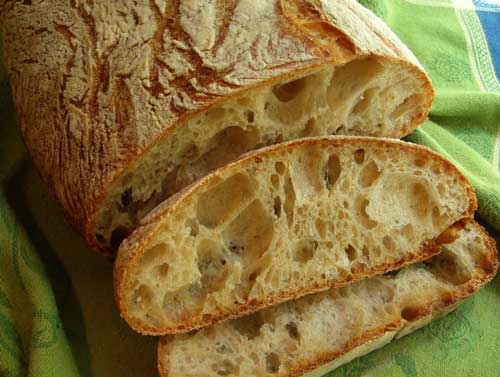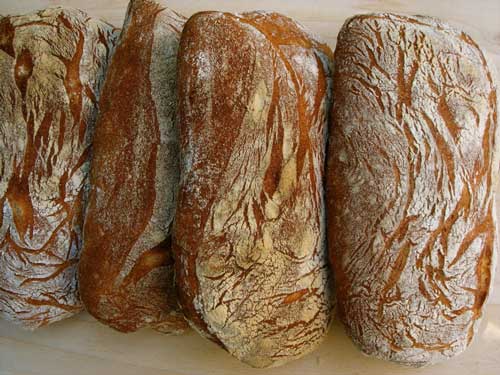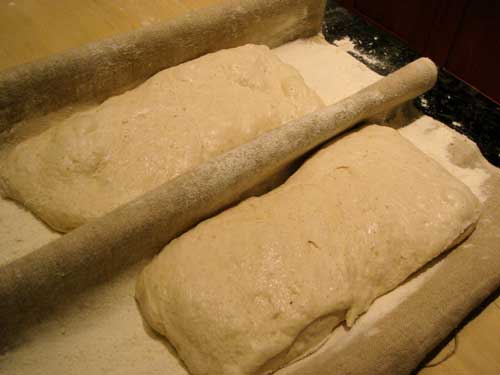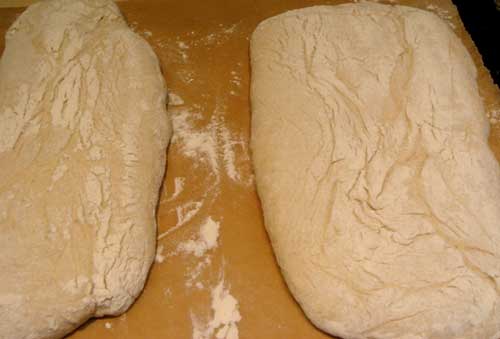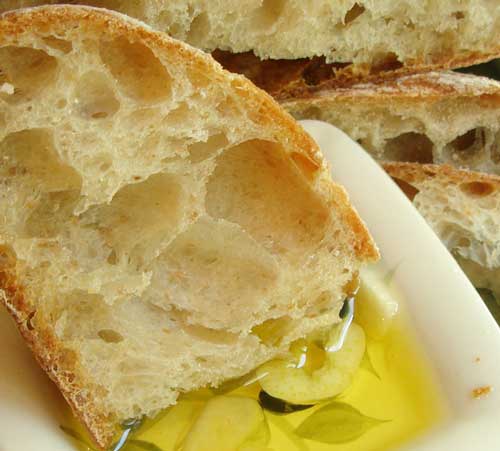Overnight Ciabatta
I often refrigerate my loaves after shaping, letting them finish up their final proof in the fridge overnight, for example, so that they’re ready to bake first thing in the morning, or whenever. This has proven to be a wonderful technique for controlling my baking schedule so I can fit a few other activities in (you know, little things like work and sleep).
If I have more than a couple of loaves, though, that can take up rather a lot of space in the refrigerator. When someone on The Fresh Loaf recently brought up the subject of retarding (refrigerating) the dough during its initial fermentation to save on fridge space, I realized that was a pretty good idea, which I had not considered before, especially for breads that proof in a space-greedy couche (thanks, beenjamming!). Then in my recent class at SFBI, retarding was covered in some depth and it was confirmed that, yes, bulk retarding is a very fine strategy. One of the breads we made to illustrate this was a ciabatta, which recipe I have adapted here by substituting a little whole wheat flour and increasing the water to satisfy that thirsty flour.
This bread does take two days to make, but the hands-on time is really quite minimal, and the retarding step offers some flexibility in timing that you don’t get with non-retarded doughs. And while you can’t exactly bake it first thing in the morning, because it does need time for the final proof after you take it out of the refrigerator, it’s still great if you want to be able to bake fairly early in the day (well in time for lunch). I made six loaves, and since only three can fit in my oven at once, I put the second three back in cold storage for a while after dividing, with still very good results.
The key to success with this ciabatta is to develop the gluten before adding all of the water. Ciabatta is a highly hydrated dough, and adding all the water in the beginning would make it difficult to develop the gluten sufficiently. By holding back about 20% of the water initially, and adding it only after the gluten has been developed to a moderate degree, a strong but soft dough can be achieved. Strength is further added by folding the dough a couple of times during the initial stage of bulk fermentation.
Overnight Ciabatta
Yield: 3 kg (six loaves)
Time:
- Mix and ferment poolish: 6 hours
- Mix final dough: 10 - 15 minutes
- First fermentation (in the refrigerator): 12 - 15 hours, with folding at the first 45 and 90 minutes
- Warm-up: 1 hour
- Divide: 5 minutes
- Proof: 1.5 - 3 hours
- Bake: 35 - 40 minutes
Poolish Ingredients:
- 457 g white flour (I used Giusto’s Golden Haven organic)
- 152 g whole wheat flour (bulk from Whole Foods)
- 609 g water at about 65F
- 2 g instant yeast (2/3 t.)
Final Dough Ingredients:
- 1082 g white flour
- 710 g cold water (about 40F)
- All of the poolish
- 34 g salt
- 3 g instant yeast (1 t.)
- 51 g olive oil (Note: I omitted this when I originally posted the recipe. Sorry!)
Method:
- In a large bowl, mix all the poolish ingredients until just combined. Cover the bowl and let the poolish ferment at room temperature for about 6 hours. The poolish is ready to use when the surface is creased, and pebbled with bubbles.
- Place all of the final dough ingredients, except about 20% of the water, into the bowl of a stand mixer. Mix on low speed until the ingredients are incorporated, about 4 or 5 minutes.
- Continue mixing on low or medium speed until the dough reaches a medium level of gluten development. This might take about 5 minutes, but will depend on your mixer.

- Add the remaining water and continue mixing until it is all incorporated and you have a dough that feels very soft but strong and springy.
- Transfer the dough to an oiled container.
- Check the temperature of the dough. If it is around 72F, leave it out at room temperature until after the second fold, but if it is warmer (mine was 80F), put it in the refrigerator right away, taking it out only to fold.
- Fold the dough at 45 and 90 minutes. Make sure the container is very well oiled after the second fold so the dough will not stick when it is turned out onto the counter later.

- After the second fold, refrigerate the dough for 10 - 14 hours.
- Take the dough out of the refrigerator and let it warm up for about one hour.
- Turn the dough out onto a very well floured counter (you really can’t get too much flour here; you want to make sure the dough doesn’t stick, and any excess will just be left behind on the counter).
- Working from the center towards the edges, very gently stretch the dough into a rectangle about 2 cm in height. Try to degas the dough as little as possible.
- With a dough scraper, cut the dough into six rectangles (3 x 2). Gently lift these pieces to a liberally-floured couche, supporting the entire piece from underneath with your flat hands, keeping the floured side of the dough down. Again, be very careful to degas as little as possible.
- Cover the couche with plastic or slip it, on a board or sheet pan, into a large food-grade plastic bag.
- Proof for 1.5 - 2 hours at room temperature, until the dough is very light and full of gas. Alternatively, place the loaves in the refrigerator for 2 hours, then another hour at room temperature.
- Meanwhile, preheat the oven, with baking stone, to 475F. You will also need steam during the initial phase of baking, so prepare for this now.

- Prepare a piece of parchment paper the size of your baking stone, and put it on a board or sheet pan.
- To transfer the loaves from the couche to the parchment, lightly sprinkle them with flour. Holding the edge of the parchment-covered pan right next to the edge of a loaf, grab the end of the couche, pull it taut and use it to flip the loaf over onto the parchment, so the heavily floured side is now up. Do this maneuver as gently as possible.
- To bake, slide the entire loaf-laden parchment onto the baking stone.
- Once the loaves are in the oven, turn the heat down to 450F. Bake for 8 minutes with steam, and another 20 minutes or so without steam. The crust should be a deepish golden brown. Once the crust is the color you want it, turn off the oven and leave the loaves in, with the door cracked open, for another 10 -12 minutes.
- Cool on a wire rack. Wait until completely cool to cut and eat.
'베이킹 > 담아온 레서피' 카테고리의 다른 글
| How to Make Pesto like an Italian Grandmother Recipe (0) | 2008.10.01 |
|---|---|
| Best Pizza Dough Ever Recipe (0) | 2008.10.01 |
| Baked Doughnuts Recipe (0) | 2008.10.01 |
| 환상적인 치아바타1 (0) | 2008.09.26 |
| Bob's Redmill - Whole Grain Recipes (0) | 2008.09.24 |
| KAF - Whole Grain Recipes (0) | 2008.09.24 |
| Bob's Redmill - Oat Flour Pie Crust (0) | 2008.09.23 |
